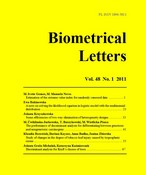
Biometrical Letters vol. 48(1), 2011, pp. 1-22


In the field of Statistics of Extremes, the most common assumption on any set of univariate data is to consider them as a complete sample of either independently and identically distributed or weakly dependent and stationary observations, from an unknown distribution function F. However, in the analysis of lifetime data, observations are usually randomly censored. We assume the case of random censorship, and dedicate our attention to the estimation of the extreme value index (EVI), the primordial parameter of extreme events. Such a parameter measures the heaviness of the right tail and its estimation has been widely studied in the literature, for complete samples. If we are under a random censor scheme, any of the common EVI estimators needs to be slightly modified in order to be consistent. We shall pay special attention to such estimation, making use of an adequate set of semi-parametric EVI estimators, among which we select second-order reduced-bias estimators. The performance of those estimators will be illustrated through the use of Monte Carlo simulations and the application of the methodology to a few sets of survival data, available in the literature.

extreme value index estimation, censoring schemes.

